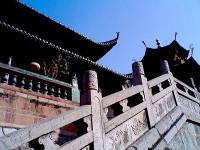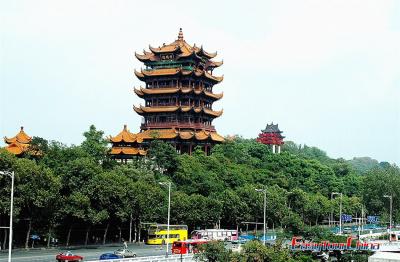Changchun Taoist Temple
 Located south of Shuangfeng Mountain, at Da Dong Men, Wuchang District, Wuhan City, Changchun Taoist Temple is the largest and most well-preserved Taoist Temple in Wuhan. Renowned as a blessed place in the south of Yangtze River for generations, it was listed as a key national Taoist temple by the State Council in 1983.
Located south of Shuangfeng Mountain, at Da Dong Men, Wuchang District, Wuhan City, Changchun Taoist Temple is the largest and most well-preserved Taoist Temple in Wuhan. Renowned as a blessed place in the south of Yangtze River for generations, it was listed as a key national Taoist temple by the State Council in 1983. During the Yuan Dynasty (1271-1368), Qiu Chuji, the patriarch of the Quanzhen Sect and founder of Long Men Zong (a branch of Taoism), came here to cultivate himself and propagandize the Taoism, later the Taoist temple was built by the disciples of Qiu Chuji to commemorate him. As Qiu Chuji was called Changchun, the Taoist Temple was called Changchun Taoist Temple and it worships Quanzhen. Since then, the temple has become a place for Taoists’ self-cultivation and religious activities.
Since its establishment, the Changchun Taoist Temple had been expanded in the Ming Dynasty (1368-1644) and the Qing Dynasty (1644-1911) and thus formed the current scale. The scale of the architectural complex is magnificent; the main buildings include the Temple Gate, the Lingguan Hall, the Taiqing Hall and the Sanhuang Hall, etc. Changchun Taoist Temple is the only building with Tibetan and European styles. The traditional craftsmanship of ornamental design on the eaves had been lost to the world, which is really a wonder. An astronomical panoramic sketch carved on the wall of the Gongde Temple by
 the famous Taoist Li Li'an is of high value to the research on ancient astronomy. The stone inscription“Gantang”, inscripted by Emperor Qianlong, is also an important cultural relics in the temple.
the famous Taoist Li Li'an is of high value to the research on ancient astronomy. The stone inscription“Gantang”, inscripted by Emperor Qianlong, is also an important cultural relics in the temple.Nowadays, Changchun Taoist Temple is not only a gathering place for Taoists, but also an elegant tourist attraction in Wuhan for its beautiful scenery, gorgeous mountains and blessed caves. This quiet blessed temple makes people shuffled back and forth between history and modern civilization.
More Attractions in Wuhan


